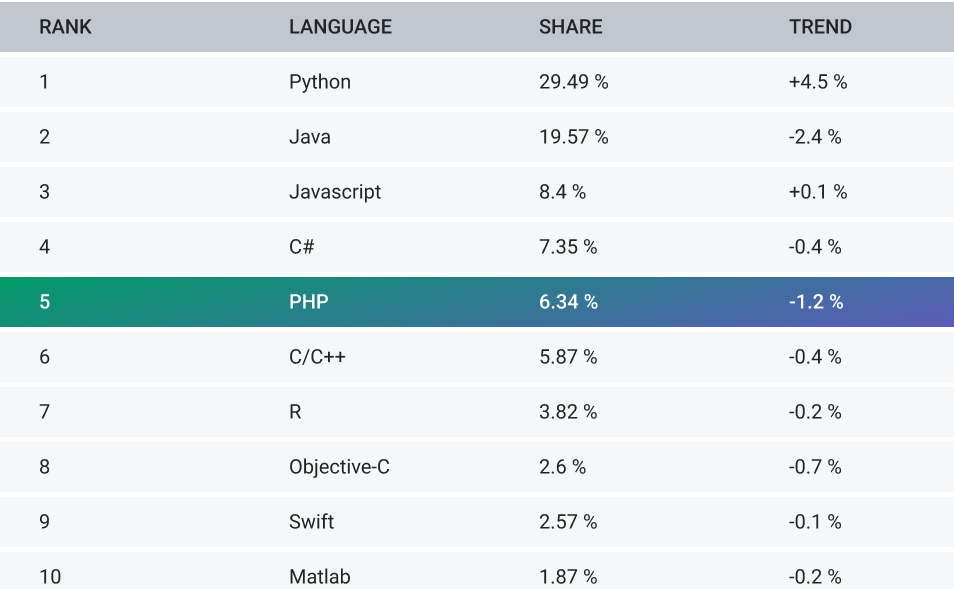PHP: A Comprehensive Guide to Its Features, Advantages, and Drawbacks
PHP has been a cornerstone of web development for many years, powering over 77% of websites, including well-known names like Etsy, Slack, and Facebook. Its versatility allows developers to use it as a robust backend language or a full-stack language for building interactive websites. However, with the rise of other dynamic languages such as Python, Perl, Java, and Swift, it’s crucial to understand the advantages and drawbacks of PHP to use it effectively in your projects.
What is PHP?
PHP, or Hypertext Preprocessor, is an open-source scripting language created in 1994 by Rasmus Lerdorf. It is particularly well-suited for web development and can be embedded into HTML. PHP’s latest version, 8.2, offers enhanced features for developing dynamic websites and reusable functions.
Here’s a basic example of a PHP script that outputs “Hello, World!” to the browser:
php
Copy code
<?php echo “Hello, World!”; ?>
Key Features of PHP
- Extensive Library: PHP provides a wealth of pre-written code libraries that streamline development tasks. Frameworks like Laravel, Symfony, and CodeIgniter offer comprehensive tools to enhance coding speed and efficiency.
- Adaptability: PHP is highly adaptable, allowing developers to make changes or add new features without rewriting code from scratch. It also integrates seamlessly with various languages and technologies.
- Database Support: PHP supports connections to over 20 databases, including MySQL, PostgreSQL, and Oracle, making it a versatile choice for web development that requires robust database interactions.
- MVC Architecture: PHP frameworks follow the Model-View-Controller (MVC) architecture, separating the presentation layer from the business logic. This modular approach simplifies the development and maintenance of complex applications.
Advantages of PHP
- Open-source and Free-to-use: PHP is free and open-source, with no licensing fees for frameworks, libraries, or databases. This makes it a cost-effective choice for developers and businesses.
- Easy to Learn and Use: PHP has a gentle learning curve, supported by extensive tutorials, resources, and a user-friendly graphical interface. Its syntax is intuitive, making it accessible even to beginners.
- Platform Independent: PHP runs on various platforms, including Windows, Linux, and macOS. Its interpreted nature means it can execute code across different environments without compatibility issues.
- Community Support: PHP boasts a large and active community. Developers can seek help and share knowledge on numerous forums and platforms, ensuring continuous improvement and support.
- Scalability: PHP is scalable, allowing for the addition of new features and functionalities as a website grows. Its performance can be enhanced through integration with other technologies, ensuring faster loading times and improved user experience.
Drawbacks of PHP
- Limited Customization: While PHP is excellent for creating dynamic websites, it may fall short for projects requiring advanced technologies like machine learning, AR/VR, or big data analytics.
- Security Concerns: Being open-source, PHP’s code is accessible to everyone, potentially exposing it to security vulnerabilities. Without proper security measures, PHP applications can be susceptible to attacks such as SQL injection and XSS.
- Easier Alternatives: Despite its ease of use, other languages like Python offer greater simplicity, flexibility, and a modern approach. Node.js, for instance, enables server-side scripting with JavaScript, providing a competitive alternative to PHP.
- Less Versatility: PHP might not offer the same level of creative flexibility as newer languages. It can be slower and less efficient compared to modern alternatives, which can impact performance and development speed.
- Limited Debugging Options: PHP’s debugging tools are not as robust as those available for other languages, making error detection and resolution more challenging.
Cost of Developing a Website with PHP
The cost of hiring PHP developers varies by region. In the India, rates range from $10 to $40 per hour, while in Australia, they can go up to $50 to $100 per hour. The total cost of development also depends on the project’s complexity, size, features, and ongoing maintenance requirements.
Conclusion
PHP remains a powerful and widely-used language for web development, offering numerous benefits like ease of use, extensive library support, and scalability. However, it also has its limitations, particularly in terms of security and versatility. By understanding its strengths and weaknesses, you can make an informed decision about whether PHP is the right choice for your web development needs.
For projects requiring a modern, flexible approach, exploring alternatives like Python or Node.js might be beneficial. Ultimately, the choice of technology should align with your project goals, budget, and desired outcomes.
